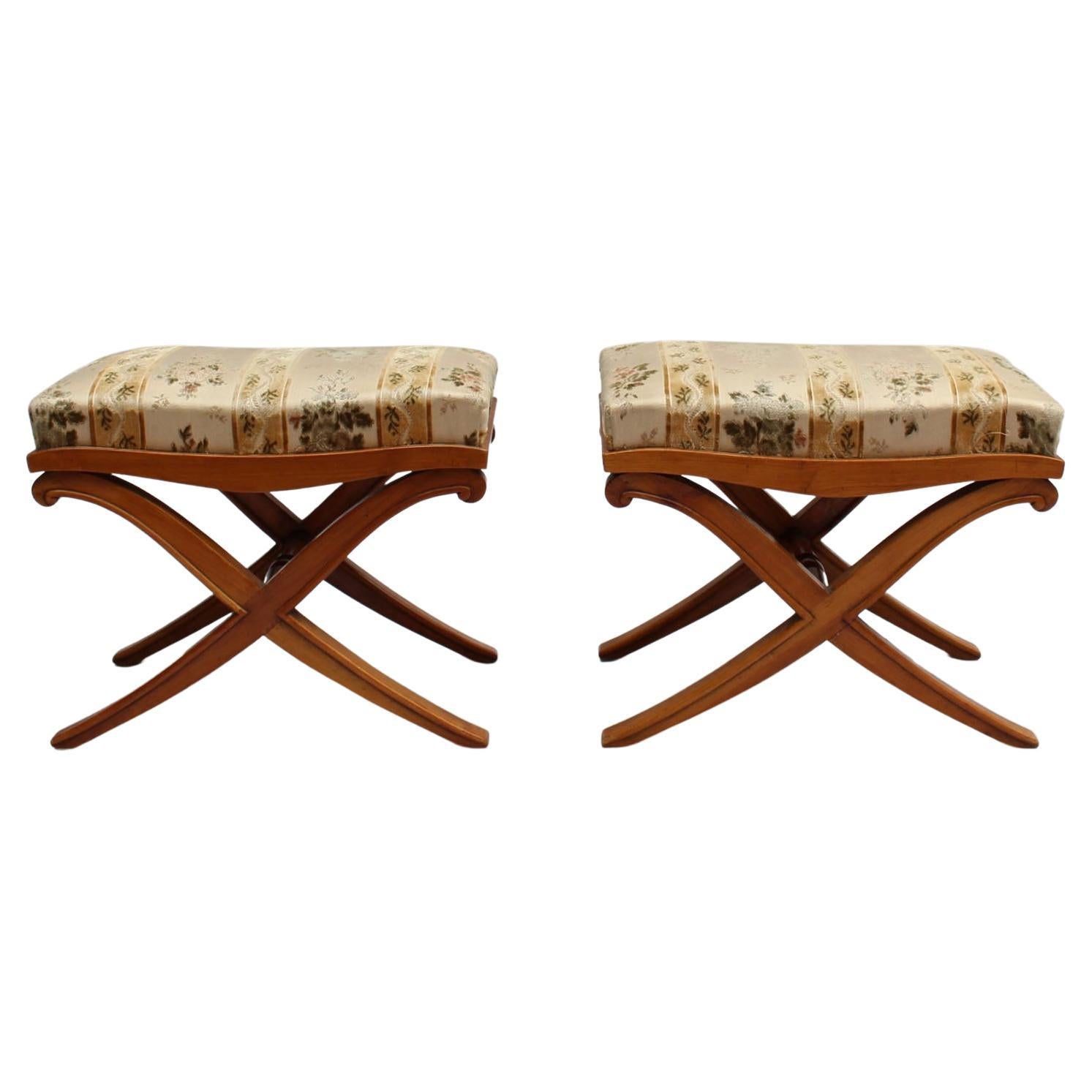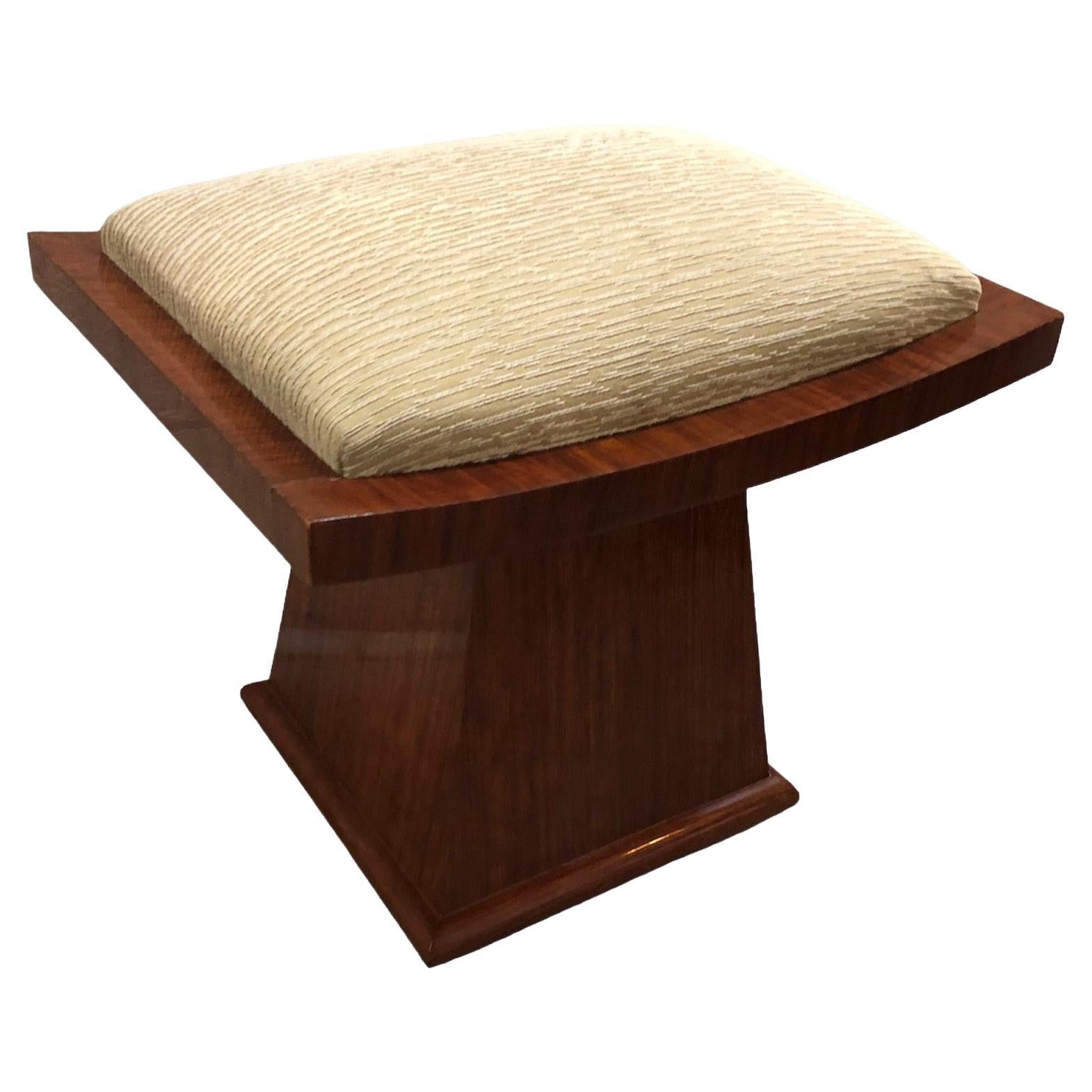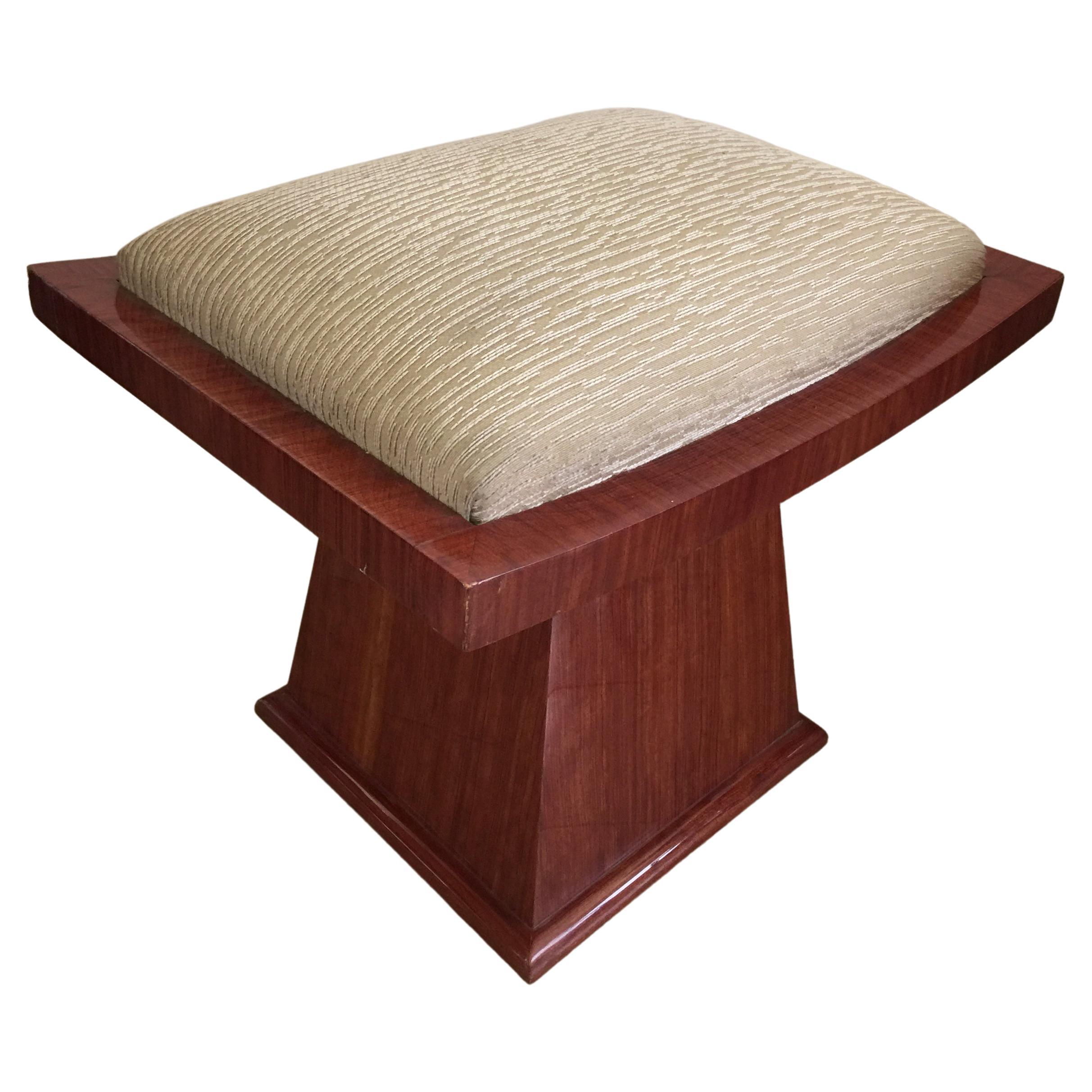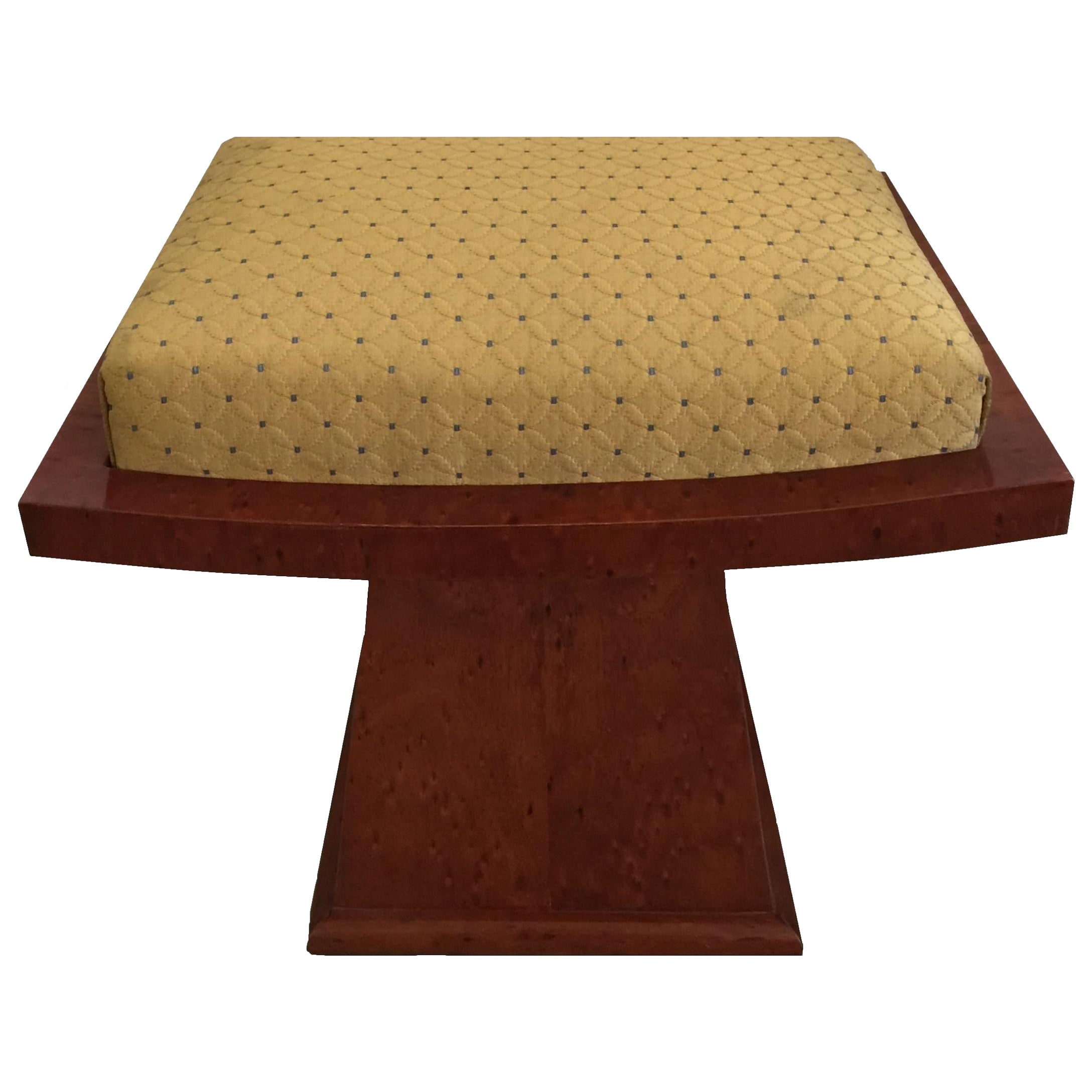Items Similar to Art Deco Stool
Want more images or videos?
Request additional images or videos from the seller
1 of 10
Art Deco Stool
About the Item
French 1940s stool in ebonized wood, with red lacquer and gold leaf
Would fit well in an eclectic evocative decor inspired by Kelly Wearstler.
- Dimensions:Height: 20.08 in (51 cm)Diameter: 13.78 in (35 cm)Seat Height: 20.08 in (51 cm)
- Style:Art Deco (In the Style Of)
- Materials and Techniques:
- Place of Origin:
- Period:
- Date of Manufacture:1940s
- Condition:Wear consistent with age and use.
- Seller Location:Antwerp, BE
- Reference Number:1stDibs: LU933423296252
About the Seller
4.8
Gold Seller
These expertly vetted sellers are highly rated and consistently exceed customer expectations.
Established in 2008
1stDibs seller since 2012
981 sales on 1stDibs
Typical response time: 10 hours
- ShippingRetrieving quote...Ships From: Antwerp, Belgium
- Return PolicyA return for this item may be initiated within 14 days of delivery.
More From This SellerView All
- Modernist Stool by H. Wouda, 1924By H.Pander & Zonen, Hendrik WoudaLocated in Antwerp, BEModernist yellow stool, Hendrik Wouda, H. Pander & Zonen, Netherlands, 1924. Painted pine, silk. The Interbellum, the period between the two World Wars, was a time when culture...Category
Vintage 1920s Dutch Modern Stools
MaterialsBelgian Black Marble
- Scandinavian Minimalistic Four-Legged Pine Stools, 1950sBy Charlotte PerriandLocated in Antwerp, BEScandinavian; Minimalistic; pine; wood; four-legged; stools; 1950s; Craftsmanship; Woodworking; Charlotte Perriand; Scandinavian Modern; Scandinavian minimalistic four-legged pin...Category
Vintage 1950s Scandinavian Scandinavian Modern Stools
MaterialsPine
- Steel Art Deco Bar Stools, Belgium, 1950sLocated in Antwerp, BEHammered steel bar stools, inspired by the sleek lines and geometric patterns of Art Deco design. These stools feature round fabric seating in an Art Deco print atop hammered steel l...Category
Vintage 1950s European Art Deco Stools
MaterialsSteel
- Brutalist Art Populaire Stools, France, 1950sLocated in Antwerp, BEBrutalist Design; Dark Solid Wood; Monoxylite; Folk Art; Travail Populaire; Art Populaire; Wabi Sabi; Stools; Mid-Century; 1950s; France; Brutalist stools, beautiful handmade pieces...Category
Vintage 1950s French Brutalist Stools
MaterialsWood
- "Art Populaire" Folk Art Stool from the Auvergne, Mid-Century Rustic 1800'sLocated in Antwerp, BEMid-century; rustic; "Art Populaire"; Folk art; Stool ;Auvergne; France; 1800s Mid-century rustic "Art Populaire" Folk art stool. This chair is from the Auvergne, France and we da...Category
Antique Early 1800s French Folk Art Armchairs
MaterialsWood
- Functional Art Chair / Stool "Plaster Whip" by Lionel JadotBy Lionel JadotLocated in Antwerp, BE"Plaster Whip" sculpture by Lionel Jadot A stool made of leftover plaster vats from a molding company, scrap metal, leather whips from the 1950s and a bodybuilder’s belt from the 1930s Collectible Design / Functional art , Lionel Jadot for Everyday Gallery, Belgium 2020 Born in Brussels in 1969, Lionel Jadot is an interior designer, artist, designer, filmmaker, adventurer. But all at once, preferably. Lionel Jadot is firing on all cylinders. ‘I never throw anything, I pick up everything. Not having a green thumb, I’m trying cuttings, weddings against nature. I never forget a line.’ He’s inviting us in subtle, off-beat worlds, on the edge of reality. Its material is made of dilated time. A wandering spirit, he seeks a protective balance in a hostile world. It is his constant questioning: what happens to the place where we live? For Lionel Jadot, everything is object, everything is history. He draws from other places, other times, and seeks what’s linking them. He sews, stitches, unpicks, blends materials, combines eras. He will enshrine some wood essence in metal, some mineral in a plant, the old in the new. ‘I take extra care to the joint between two materials.’ With him, there is always some play in the parts, as in a piece of machinery. From a kingdom to another, he provokes organic, viral growths, generating energy. Linking past and future, he never forgets a line. ‘I accumulate them.’ He’s inviting us in subtle worlds, off-beat, on the edge of reality. Are we in 1930 or in 2030? Both, no doubt. Its material is made of dilated time. The eye goes hand in hand with the ear. ‘When I walk into a place, I listen to the good (or bad) it does to me. An ineffable feeling.’ He recreates mutant buildings, like the future Royal Botanique, a 5 stars hotel housed in the Church of the Gesu, a former convent behind a 1940 façade. He talks about a ‘hotel object’, which he holds and turns around in his hand. A wandering spirit, he’s flirting with retro-futurism. The Jam, another hotel, is intended for urban travelers, fans of swiftness, fluidity and hospitality. He designs interiors as a set of objects: a motorcycle cut in concrete becomes a bar counter. He finds gothic cartoon echoes, from the likes of Moebius, Alejandro Jodorowsky, Enki Bilal, sets from Garage Hermétique and Blade Runner, a protective balance in a hostile world. Discovering Jadot’s little cosmos of collected and accumulated goods, it becomes clear that every element has its own story. I tried to collect them and in turn, devour them in the coming paragraphs. But first: the show is best experienced seated, barring the distinction between object of use and object of attention, they invite for different types of conversation. The seats, chairs, thrones all make us think of our own physical comportment, and of how the seat lends grandeur to the person sitting on it, by crowning its presence. The crackling floor, the felt walls and the diffuse light slow you down into an oddly absorbing environment, in which you are left puzzled. In the eclectic collages of objects, bits and pieces collected all over the world come together in ways practical, and logical, though possibly only in the artist’s mind. All his finds eventually seem to fall into place. Starting with the mere conception of a chair, rather than with a set-out plan or sketch, the works are intuitively construed out of an archive that one can only imagine the dimensions of. Things forgotten by others, precious for him, were all once designed for their own purpose. Here they find their fit as a base, a closing system or a balancing element. The first piece that opens the exhibition, the most throne-like of all seats in the show, builds around a chair of his grandmother, protected by mops, and harassed with bed springs. As you enter the space, you pass by a shell leaning over a yellow seat that stems from his old Mustang, and find a white stool piece with Mexican leather dog training whips— the white building blocks of which turn out to be dried molding material, as found and broken out of a bucket by workers every morning. Further, the stone piece that reminds one of the stone age, is indeed made of 400 million old rocks, and the soft seats are lent from construction, where these strokes of textile carry up the heaviest goods. In the corner — but as you walk this walk please be seated on any of the thrones and experience the work for a moment— the green fluffy cover is made by XXXX who remakes cartographies of warzones, one of which is here mounted on a flexible fishing chair. On an experience level, the conversation chair enhances self-confidence, while putting you literally in a good spot with the person you’re conversing with. The lamp perfectly shows the playful Cadavre Exquis...Category
2010s European Chairs
MaterialsLeather, Plaster
You May Also Like
- Art Deco Stool Ottoman, FootstoolLocated in Vienna, ATWalnut frame with curved legs and new upholstery with Lelievre fabric. Made by an unknown Austrian furniture maker, circa 1930.Category
Vintage 1930s Austrian Art Deco Footstools
MaterialsWalnut, Upholstery
- Art Deco Stool, Material Iron, Country France, 1930Located in Ciudad Autónoma Buenos Aires, CStools Art Deco. Material: iron You want to live in the golden years, this is the stool that your project needs. We have specialized in the sale of Art Deco and Art Nouveau styles since 1982.If you have any questions we are at your disposal. Pushing the button that reads 'View All From Seller'. And you can see more objects to the style for sale. Why are there so many antiques in Argentina? In the 1880 – 1940 there was a grate wave of immigration encouraged by the periods of war that were taking place. 1st World War took place between 1914 and 1918 2nd World War took place between 1939 and 1945 The immigrants options were New York or Buenos Aires. Tickets were cheap and in Buenos Aires they were welcomed with open arms, as it was a country where everything was still to be done. Argentina was the country of new opportunities, labour was needed and religious freedom was assured, in many cases the of the family travel first until they were settled and then the rest of the family members join them. In the immigrant museum “Ellis Island Immigrant Building” in New York you can se the promotional posters of the boats that would take them to a new life. Between the years 1895 and 1896, Argentina had the highest DGP (gross domestic product) per capita in the world according to the Maddison Historical Statistics index, this situation arose due to the large amount of food being exported to European countries, which were at war. The Argentinean ships left the port of Buenos Aires with food, but they returned with furniture, clothes and construction elements, (it´s common to see this the old buildings of the historic neighbourhood of San Telmo, the beams with the inscription “Made in England)”, as well as many markets that were built in Buenos Aires, such us the San Telmo Market, whose structure was brought by ship and afterwards assembled in 900 Defensa Street. With the great influence of European immigrants living in the country, the children of the upper classes travelled to study in France, resulting in the inauguration of “La Maison Argentinienne”, on 27th of June 1928, in the international city of Paris, which hosted many Argentinians that were studying in Frace. It´s the fourth house to be built after France, Canada and Belgium, being the first Spanish-speaking one. Still in place today (17 Bd Jourdan, 75014, Paris, France). Many of the children of these wealthy families who attended international art exhibitions, museums and art courses abroad, took a keen interest in the European style. This is why Buenos Aires was at the time referred as “The Paris of South America”. Between the years 1890 and 1920 more than a hundred Palaces were built on Alvear Avenue the most exclusive avenue in Buenos Aires. Today some of these palaces have been transformed into museums, hotels and embassies. In the year 1936, the Kavanagh building was inaugurated, it was the tallest reinforced concrete building in South America. During 1994 the American Society of Civil Engineers distinguished it as an “international engineering milestone”, and it´s now considered a World Heritage of Modern Architecture. At the time was common to hire foreign architects such as Le Corbusier, who visited Buenos Aires/Argentina in 1929 and in 1948 he drew up the blueprints for a house built in La Plata City (which was declared a World Heritage Site). In 1947, the Hungarian architect Marcelo Breuer designed “Parador Ariston” in the seaside city of Mar del Plata. After an Argentinean student at Harvard University convinced him to come to Argentina. He worked on an urban development project in the Casa Amarilla, area of La Boca. The Ukrainian architect, Vladimiro Acosta, arrives in Argentina in 1928 and worked as an architect until que moved to Brazil. Antonio Bonet, a Spanish architect who worked with Le Corbusier in Paris, arrives in Argentina in 1937, where he carried out several architectural works and in 1938 designs the well-known BFK chair. Andres Kálnay, of Hungarian origin, made around 120 architectural masterpieces, among which the former Munich brewery stands out, he even made the furniture’s design. The German architect, Walter Gropius, director of the Bauhaus, lived in Argentina, where he wrote articles for “Sur” magazine and founded in Buenos Aires, an architectural firm with Franz Möller, who was also an architect, where he built two houses. At the same time several famous designers decided to immigrate to Argentina, among them we can find the well-known French designer, Jean-Michel Frank, who arrived in the country in 1940 and also worked for the Rockefeller family. Special pieces were made, which were sold exclusively in the country, such as the well-known German company “WMF”, who sold their products by catalogue, which were chosen by the ladies of high society in the list of wedding gifts, as well as the pieces designed by Christofle. The Swiss sculptor Alberto Giacometti, made special pieces for Argentinean mansions. In 1904 the first Jansen branch outside Paris was established in Buenos Aires, as the Argentinean clientele demanded a large amount of furniture, from the end of the 19th century to the mid-20th century. In 1970, the brand Rigolleau Argentina made pieces authorised by Lalique. The brands Maple and Thompson also set up shop in the country. The French plastic artist, Marcel Duchamp moved to Argentina in 1918-1919. Glass signed Gallé, Charder, Leverre, Schneider, Muller and other French firms. They were bought in flower shops and were given to ladies with beautiful floral arrangements. Some furniture manufacturers travelled to international fairs and bough the patterns to produce the furniture in Argentina, such as the furniture firm Englander and Bonta, who bought the patterns ins Italy. It is worth mentioning that in Argentina we have the largest community of Italians outside...Category
Vintage 1930s French Art Deco Stools
MaterialsIron
- Pair of Fine French Art Deco X-Form StoolsLocated in Long Island City, NYA pair of fine French 1940s X-form stool in cherry wood.Category
Vintage 1940s French Art Deco Stools
MaterialsWood
- Art Deco Stool in Wood, Country France, 1930Located in Ciudad Autónoma Buenos Aires, CStools Art Deco. Material: wood You want to live in the golden years, this is the stool that your project needs. We have specialized in the sale of Art Deco and Art Nouveau styles s...Category
Vintage 1930s French Art Deco Stools
MaterialsWood
- Art Deco Stool, Material Wood, Country France, 1930Located in Ciudad Autónoma Buenos Aires, CStools Art Deco. Material: wood You want to live in the golden years, this is the stool that your project needs. We have specialized in the sale of Art Deco and Art Nouveau style...Category
Vintage 1930s French Art Deco Stools
MaterialsWood
- Art Deco Stool, Year 1930, Material Wood, Country FranceLocated in Ciudad Autónoma Buenos Aires, CStools Art Deco. Material: wood You want to live in the golden years, this is the stool that your project needs. We have specialized in the sale of Art Deco and Art Nouveau style...Category
Vintage 1930s French Art Deco Stools
MaterialsWood
Recently Viewed
View AllMore Ways To Browse
Ebonized Wood Art Deco
Retro Stool Red
Art Deco Wood Stool
French Deco Stool
French Art Deco Stool
Ebonized Wood Stool
Red Lacquer Stool
French Stool 1940s
Art Deco Stools Retro
Stool Red Gold
French Gold Stool
Mid Century Gold Stools
French Art Deco Red Lacquer
1940s Kelly
Kelly Wearstler Art
Art Deco Wood Footstools
Gold Kelly Wearstler
Gold Leaf Kelly





